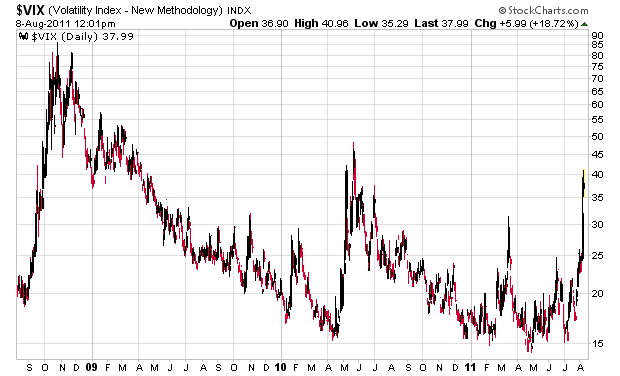This upcoming week in the markets is probably going to be the most interesting since March 2009 when the S&P 500 hit the famous “666” mark.
As I write this, the S&P futures are down 1.9%, gold is up a whopping US$59/Oz and oil is down $2.85. There is clearly a large amount of panic being baked in the marketplace. The cause is being attributed to the S&P downgrade of the US soverign debt but this is the trigger, not the cause. There are a lot more macroeconomic problems going on in the world that have attributed for this market meltdown while everybody tries to rush for liquidity.
August volatility futures were sleepy until they exploded in the past week:

I had earlier said that the market panic is likely to be over when it has reached 30-35, but I am now of the mindset that the volatility can get higher before the market has seen capitulation – I’m guessing now around 40-45.
Even when there is capitulation, the bears will likely not be done yet – part of dealing with market downtrends is that there will be significant periods of time (one or two weeks) where you will see sharp market rallies and people with cash on the sidelines will be stepping over themselves to get back into the marketplace. These will simply be more moments to lose money. As long as there are columnists and people on the television that are willing to say that this volatility presents a good time to purchase stocks, I do not believe this downtrend is over – it has just started.
What is incredibly contrary to the market action is the fact that corporate profits appear to be at incredibly reasonable levels compared to prevailing interest rates provided by “safe” (ahem) government bonds. It could be the case the market is predicting that such profits are going to evaporate in the near future or that such profits simply do not matter and liquidity is what is being traded, rather than equities in companies with solid fundamentals.
Investors must be able to be nimble on their transactions and try to buy when supply is at its highest, while selling when the demand has almost peaked. Selling in downturns or buying in uptrends will result in very sloppy executions.
This is reminding me of two other situations in the past. One was in the year 2000, when the Nasdaq went from 5,000 in March and crashed all the way down to about 3,000, only to climb back up to 4000 again in August before crashing to its ultimate low of about 1100 in October 2002. There was one day (April 4, 2000) where the Nasdaq went from 4283 down to 3649 intraday (a 15% drop), only to recover to 4148 at the end of trading (a 14% recovery). This was the most volatile day of trading I had ever experienced and was an omen that there were bad things coming down the pipeline.
Last Thursday was all down, but if my hunch is correct, we are going to see a lot of volatility this week, so be prepared to ride those ups and downs like a professional ocean surfer. Monday is going to start down, but the rallies and downturns are going to be as sharp as a razor blade.
That said, so many people think that the markets will tank on Monday that I would venture they main indices (S&P 500, TSX) will end the day up.



